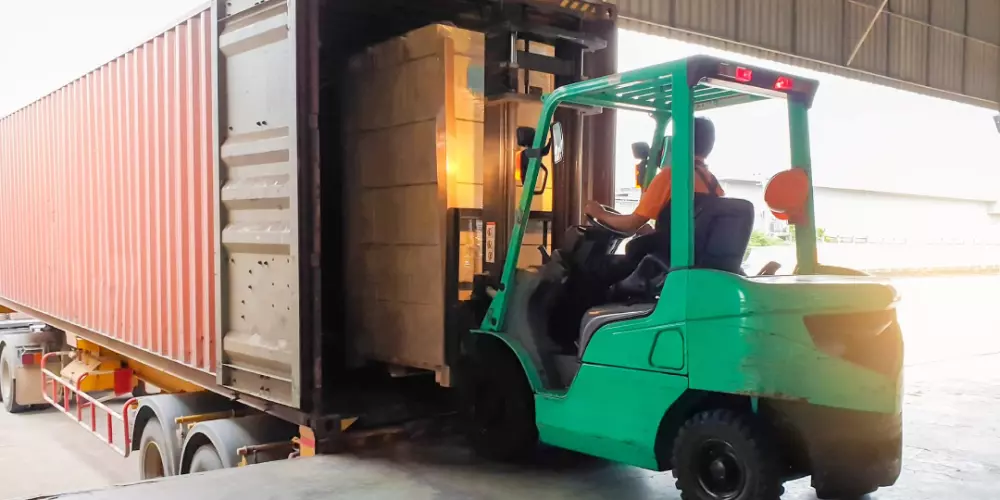Underutilized warehouse space and increased inventory holding periods can be costly for manufacturers. Fortunately, the industry has adopted different strategies to increase warehouse utilization and reduce unnecessary costs associated with inefficient warehouse space utilization.
One of these strategies is called Just-in-Time (JIT) delivery. Just-in-Time delivery revolves around the concept of having finished goods delivered to a warehouse at the time they are required. This allows warehouses to fulfill orders for consumers, distributors, and even other downstream manufacturers with minimal inventory.
Just-in-Time delivery has gained worldwide recognition since its inception and is becoming an important process and supply chain management strategy for businesses.
However, adopting this strategy can place a significant amount of strain on logistics service providers, mainly trucking companies and owner-operators, if not implemented correctly.
In this article, we’ll provide more insights into the concept of Just-in-Time delivery and explain how the model works. We’ll also share a brief guide for carriers looking to implement the practice and share the key advantages and disadvantages.
What is Just-In-Time Delivery?
The concept of “Just-in-Time” comes from a Japanese management philosophy that many manufacturing organizations adopt today. The concept was developed in the early 1970s by Taiichi Ohno, who is regarded as the father of the Toyota Production System, which focuses on maximizing output and efficiency while adopting tight schedules and reducing supply chain wastage.

Although the model was introduced with the intention of producing goods on demand instead of in surplus, it has been applied to freight transportation and warehousing. Most larger manufacturers impose Just-in-Time delivery requirements for their warehouses.
Carriers incorporate this requirement by scheduling their delivery trucks according to what their customers require at a given time. This helps to reduce inventory holding costs, by lowering overall warehouse space for holding inventory that is not required and increasing inventory turnover.
With JIT, suppliers produce finished or semi-finished products in preparation for incoming demand. The key purpose of this model is to reduce resource and financial wastage in terms of warehouse space to hold inventory that is not required.
It can also help to minimize the spoilage of perishables and overhead expenses associated with running the business, such as insurance, rent, and utilities.
How Can Carriers Implement the Just-In-Time Delivery Strategy?
Just-in-Time delivery for trucking companies isn’t too different from conventional day-to-day trucking operations. Trucking companies operating on this model communicate, coordinate, and receive orders with specific delivery requirements.

They also plan the most efficient routes, optimize loads for maximum capacity utilization, and employ different technologies for timely deliveries, like real-time tracking. As you can see, the practice is rather straightforward.
The only catch is to manage all of the operations with great precision and overcome all the hurdles involved in the process. Below, we’ll explain the key factors to consider before implementing the JIT delivery strategy.
Infrastructure
To successfully implement JIT delivery, companies may need significant upfront investment to procure trucks, trailers, facilities, equipment, and resources to handle all the operations efficiently.
Depending on customer requirements, shippers may require multiple warehouses and distribution centers, truck terminals, and other facilities to streamline and successfully manage all the required deliveries.
Technology
Just-in-Time deliveries require advanced scheduling and tracking solutions. These innovations help truckers cope with the fast-paced nature of JIT operations and ensure they make the right route planning and scheduling decisions.
Truckers also need to invest in the latest communication platforms to stay connected with suppliers and manufacturers. Both parties are likely to require urgent transport, reroute shipment on demand, and even change their order requirements.
Training
As mentioned above, managing Just-in-Time deliveries requires advanced planning. As a result, all personnel, from management to drivers, need to have a comprehensive understanding of how the “Just-in-Time” concept works.
To maintain high-performance levels, carriers must provide regular training so that all team members are familiar with the customer’s business requirements and are ready to manage expectations.
Collaboration
Collaboration is one of the most important aspects of any implementation. All parties involved in the process, from clients to handlers, drivers, and receivers, need to remain in a constant loop to share up-to-date knowledge related to planning, routing, and scheduling.
Suppliers can also share their supply and demand forecast to help carriers proactively prepare for the transport by procuring and/or upgrading their fleet.
Continuous Improvement
Carriers and manufacturers should implement various continuous improvement initiatives in order to streamline processes, adopt technologies, and enhance strategies.
Carriers that offer JIT delivery services are among the few that would greatly benefit from periodic performance evaluation using fleet benchmarking. However, doing so requires them to reinvest heavily in data analytics and digital solutions with no short-term returns in most cases.
Complementary Trucking Tools & Strategies
We have identified a few tools and strategies trucking companies can use to employ to cater to Just-in-Time requirements. Let’s take a closer look at them.
Dedicated Trucking
Dedicated trucking is the practice of transporting cargo for a specific customer, whereby a part of the truck fleet is typically reserved for them. This gives carriers better control over scheduling and ensuring that delivery trucks are available on demand.
It allows them to deliver raw materials or semi-finished goods whenever the customer requires them instead of following the carrier’s scheduling and planning. However, carriers need to have enough resources to manage the operations before offering dedicated trucking services.
Electronic Logging Device (ELD)
ELDs are one of the most important innovations in the trucking industry and allow trucking companies to monitor their trucks’ movement, location, driver’s hours of service, and performance in real-time.
When delivering cargo according to Just-in-Time requirements, carriers are able to share the live location of trucks with clients and update ETAs for timely pickup and deliveries.
More importantly, both parties can better plan their operations. For instance, suppliers and manufacturers can proactively schedule equipment and resources for handling goods based on the estimated time of arrival.
Truck Terminals
Truck terminals are perhaps the most important facilities for JIT delivery practices, especially for carriers with headquarters far away from clients. These terminals are excellent facilities for freight consolidation and even provide temporary storage for loaded trucks or containers.
At these terminals, truckers can also cross-dock cargo, which involved unloading freight from one truck, temporarily storing it in a warehouse, and then loading it onto another truck.
This strategy is ideal for transporting less-than-truckload goods for clients with multiple facilities. Carriers can also minimize the need to procure multiple semi-trucks and trailers and manage these last-mile deliveries.
Transport Management System (TMS)
Transport management systems (TMS) are another essential tool trucking companies use to facilitate collaboration and communication among drivers, clients, and other stakeholders involved in transit.
They are also vital for tracking deliveries, as they provide greater visibility to truckers and their clients. A modern TMS also helps them streamline their operations, plan routes more accurately, and process orders efficiently.
Advantages of Just-In-Time Deliveries
Just-in-Time deliveries offer a wide range of benefits for trucking companies, which include the following:
- Higher Customer Satisfaction – Suppliers are actively looking for ways to reduce their inventory holding costs. By offering efficient JIT delivery services, carriers can improve their profitability and operational efficiency, leading to higher customer satisfaction.
- Lower Competition – Not all trucking companies offer JIT delivery services due to the costs and challenges involved. As a result, there’s relatively less competition, meaning trucking companies can capture a higher market share by offering these services. Additionally, lower competition would also mean that carriers can charge a premium for providing such services.
- Improved Efficiency – Adopting JIT delivery can be a strenuous endeavor. However, successful implementation would inherently challenge carriers to improve several areas of operation and become more efficient and profitable service providers.
Disadvantages of Just-In-Time Deliveries
Like all other trucking models, Just-In-Time delivery services also bring about several disadvantages for trucking companies, which we’ll be further explaining below.
- Higher Investment Requirements – Adopting Just-in-Time deliveries requires truckers to transform their operations by upgrading their infrastructure and investing in new technologies and resources. This can be an expensive venture, especially for smaller trucking companies. In many cases, carriers may have to invest in a dedicated fleet and rent truck terminals to accommodate the required scheduling.
- Complex Operational Coordination – Processes involve complex and continuous coordination between clients and trucking companies to deliver cargo On time in full (OTIF). Unfortunately, operational issues can result in delays that can affect overall efficiency and customer satisfaction.
- Reduced Flexibility – JIT requires extreme scheduling precision from carriers, which means that there is little margin for error or increased risks of last-minute changes when it comes to scheduling. Trucks dedicated to JIT clients may not be available for other loads, which could affect the utilization rate and overall flexibility.
Case Study
A trucking company called GoodTrucks was selected by a toy manufacturer called ToysGlobal as their logistics partner in delivering semi-finished goods based on Just-in-Time deliveries.
ToysGlobal has a processing factory in California that assembles toy parts using semi-finished goods that are then distributed to different facilities around the United States for last-mile deliveries.
GoodTrucks provides trucks to transport the semi-finished from the main factories to the processing factory in California. The trucking company implemented the following methodology:
- Utilized a truck terminal in strategic locations that are central to all facilities.
- Utilized their largest capacity trucks to transport goods to the truck terminal, where they perform cross-docking activities followed by last-mile deliveries with a fleet of smaller box trucks stationed at the truck terminal.
- Shared real-time GPS tracking with ToysGlobal.
By employing these strategies and initiatives, ToysGlobal saw a rapid improvement in efficiency and a reduction in inventory holding costs through higher inventory turnover.
Over time, the toy manufacturer reduced the number of warehouses and consolidated their inventory for efficiently. GoodTrucks established a solid partnership with ToysGlobal and secured more business in the long run.

Get Free Course Access
If you enjoyed the article, don’t miss out on our free supply chain courses that help you stay ahead in your industry.

Andrew Lin
Co-Founder & Writer
at freightcourse
About the Author
Andrew is a multi-business owner with over 12 years of experience in the fields of logistics, trucking, manufacturing, operations, training, and education.
Being the co-founder of freightcourse has given him the ability to pursue his desire to educate others on manufacturing and supply chain topics.
Follow us